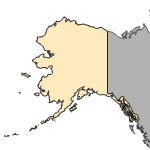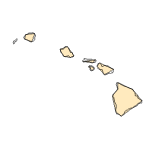Nitokra hibernica
(a harpacticoid copepod)
Crustaceans-Copepods
Exotic |
|
Common name: a harpacticoid copepod
Synonyms and Other Names: Nitocra hibernica, Canthocamptus hibernicus
Taxonomy: available through
www.itis.gov
Identification: This copepod exhibits a narrow rostrum and caudal rami that are two times longer than wide. The anal operculum generally displays 10 teeth along the edge. The 1st endopod segment is equal to or longer than the whole exopod. On the 3rd exopod segment of legs 2–4 there are 5, 5, and 7 spines, respectively (Lesko et al. 2003).
Size: Female N. hibernica are around 0.5–0.75 mm long and males are around 0.5–0.6 mm long (Lesko et al. 2003).
Native Range: Nitokra hibernica is native to Eurasia where it has a broad distribution. It occurs in such places as the Black and Caspian Seas; European coasts of the Atlantic, Arctic, and Baltic Seas; inland waters in south, east, and central Europe; and in central Asia and the Caucasus (Grigorovich et al. 2001; Lesko et al. 2003).



|

Alaska |

Hawaii |

Puerto Rico &
Virgin Islands |

Guam Saipan |
Hydrologic Unit Codes (HUCs) Explained
Interactive maps: Point Distribution Maps
Nonindigenous Occurrences:
Table 1. States with nonindigenous occurrences, the earliest and latest observations in each state, and the tally and names of HUCs with observations†. Names and dates are hyperlinked to their relevant specimen records. The list of references for all nonindigenous occurrences of Nitokra hibernica are found here.
Table last updated 12/12/2025
† Populations may not be currently present.
* HUCs are not listed for states where the observation(s) cannot be approximated to a HUC (e.g. state centroids or Canadian provinces).
Ecology: Nitokra hibernica is a benthic invertebrate that occurs in fresh, brackish, coastal, and estuarine waters, exhibiting a broad salinity tolerance. It is usually associated with macrophyte beds and can be found in nearshore zones of large rivers and lakes. In the Great Lakes, most records are from nearshore areas, though a few have been from deeper regions. It has been recorded from Yankee Reef and Saginaw Bay, Lake Huron. In England it sometimes occurs at intakes and outflows of power stations (Markowski 1959; Zankai and Ponyi 1986; Gaviria 1998; Hudson et al. 1998; Grigorovich et al. 2001; Lesko et al. 2003; Duggan et al. 2005). Sexually mature female N. hibernica can carry 17–21 eggs in one egg sac (Lesko et al. 2003).
Means of Introduction: Nitokra hibernica was probably introduced in ballast water in ships entering the Great Lakes (Duggan et al. 2005). Ballast exchange regulations for international vessels entering the Great Lakes are highly efficient at preventing introduction of international nonindigenous species (NIS), but Briski et al. have noted that a lack of ballast regulations in domestic shipping within the Great Lakes poses a threat to further spread of NIS between lakes (2012). Specifically, they sampled N. hibernica from ballast water destined for discharge in Lake Superior, where it has not yet been documented. They suggest domestic regulations be based on ecological boundaries rather than geographic and political borders to help prevent spread of NIS within the Great Lakes (Briski et al. 2012).
Status: Established where recorded.
Impact of Introduction:
A) Realized: The introductions of N. hibernica and its nonindigenous congener N. incerta are very likely responsible for the introduction to Lake Erie (by N. hibernica) and the Detroit River (by N. incerta) of the suctorian ciliate Acineta nitocrae, which is known to be epizooic on these two copepods in the Ukraine (Grigorovich et al. 2001).
N. hibernica has been collected from the stomach of one slimy sculpin (Cottus cognatus) in Lake Huron and it is known that smelt (Osmerus mordax) in Saginaw Bay, Lake Huron, feed on it (Hudson et al. 1998; Lesko et al. 2003).
B) Potential: Unknown.
References: (click for full references)
Briski, E., C.J. Wiley, S.A. Bailey. 2012. Role of domestic shipping in the introduction or secondary spread of nonindigenous species: biological invasions within the Laurentian Great Lakes. Journal of Applied Ecology 49(5):1124-1130.
Cangelosi, A., O. Anders, M. Balcer, K. Beesley, L. Fanberg, S. Gebhard, M. Gruwell, I. Knight, N. Mays, M. Murphy, C. Polkinghorne, K. Prihoda, E. Reavie, D. Regan, E. Ruzycki, H. Saillard, H. Schaefer,T. Schwerdt, M. TenEyck, K. Tudor, T. Venditto, S. Wilczewski. 2018. Great Waters Research Collaborative: Great Lakes Ship Ballast Monitoring Project Technical Report. Lake Superior Research Institute, Superior, Wisconsin.
Czaika, S. C. 1978. Crustacean zooplankton of southwestern Lake Ontario in spring 1973 and at the Niagara and Genesee River mouth areas in 1972 and spring 1973. Journal of Great Lakes Research 4: 1-9.
Duggan, I. C., C. D. A. van Overdijk, S. A. Bailey, P. T. Jenkins, H. Limen, and H. J. MacIsaac. 2005. Invertebrates associated with residual ballast water and sediments of cargo-carrying ships entering the Great Lakes. Canadian Journal of Fisheries and Aquatic Sciences 62: 2463-2474.
Garza, E. L., and R. L. Whitman. 2004. The nearshore benthic invertebrate community of southern Lake Michigan and its response to beach nourishment. Journal of Great Lakes Research 30(1): 114-122.
Gaviria, S. 1998. Colonization of a new man-made river (Marchfeldcanal, Lower Austria) by benthic copepods. Journal of Marine Systems 15(1):127-134.
GLMRIS. 2012. Appendix C: Inventory of Available Controls for Aquatic Nuisance Species of Concern, Chicago Area Waterway System. U.S. Army Corps of Engineers.
Grigorovich, I. A., I. V. Dovgal, H. J. MacIsaac, and V. I. Monchenko. 2001. Acineta nitocrae: a new suctorian epizootic on nonindigenous harpacticoid copepods, Nitocra hibernica and N. incerta, in the Laurentian Great Lakes. Archiv für Hydrobiologie 152(1): 161-176.
Hudson, P. L., J. W. Reid, L. T. Lesko, and J. H. Selgeby. 1998. Cyclopoid and harpacticoid copepods of the Laurentian Great Lakes. Ohio Biological Survey Bulletin New Series 12(2): i-vi + 1-50.
Lesko, L. T., P. L. Hudson, J. W. Reid, and M. A. Chriscinske. 2003. Harpacticoid copepods of the Laurentian Great Lakes. Great Lakes Science Center, Ann Arbor, Michigan. http://www.glsc.usgs.gov/greatlakescopepods/Key.asp?GROUP=Harpacticoid
Markowski, S. 1959. The cooling water of power stations: a new factor in the environment of marine and freshwater invertebrates. The Journal of Animal Ecology 28(2): 243-258.
Zankai, P. N., and J. E. Ponyi. 1986. Composition, density and feeding of crustacean zooplankton in a shallow, temperate lake (Lake Balaton, Hungary). Hydrobiologia 135: 131-147.
Author:
Kipp, R.M., A.J. Benson, J. Larson, T.H. Makled, and A. Fusaro
Revision Date: 9/12/2019
Citation Information:
Kipp, R.M., A.J. Benson, J. Larson, T.H. Makled, and A. Fusaro, 2025, Nitokra hibernica (Brady, 1880): U.S. Geological Survey, Nonindigenous Aquatic Species Database, Gainesville, FL, https://nas.er.usgs.gov/Queries/FactSheet.aspx?SpeciesID=2372, Revision Date: 9/12/2019, Access Date: 12/12/2025
This information is preliminary or provisional and is subject to revision. It is being provided to meet the need for timely best science. The information has not received final approval by the U.S. Geological Survey (USGS) and is provided on the condition that neither the USGS nor the U.S. Government shall be held liable for any damages resulting from the authorized or unauthorized use of the information.